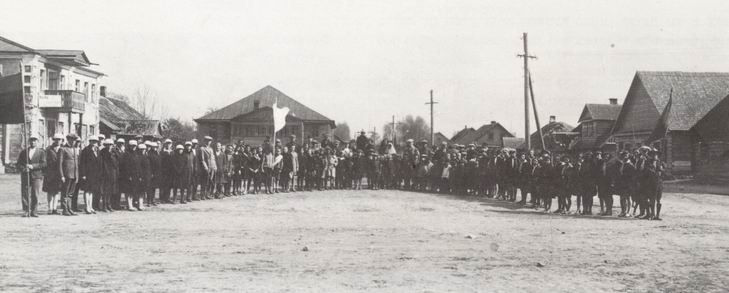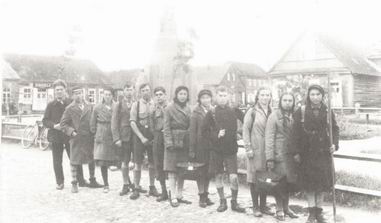Yosef Yavnai: Market Day was the day we wished and waited for all week long. It was the day on which our income for the entire week depended, the day on which the surrounding peasants gathered in the shtetl in order to sell their wares. The street was crowded with wagons, with not an inch to spare. The wagons held farm produce such as chickens, eggs, cheese, butter, vegetables and fruit. Men and women from the shtetl wandered between the wagons, buying and bargaining at the top of their lungs. Fun and games!
The Gentiles would come into the Jews' inns to gladden their hearts with a glass of vodka, and white chale (Sabbath bread) with herring to follow. Sometimes, when he was tipsy, a drunken peasant would try to cause a riot, and a policeman would immediately be called to calm things down. I remember that our Tatar maid would warn us not to go to the market if she knew that there was brawling going on there.
Rasya Tal: Wednesday, Market Day, was a wonderful day for me. We always prayed that we wouldn't have to go school that day. I remember the beautiful sight – especially in summer – when the wagons began to appear from all corners of the town. From morning, you could already hear the noise of the wagons approaching, and they were laden with grain, vegetables, chickens, eggs and … toys!
There was a special street for the cattle market: calves, cows and horses. What couldn't you find on those streets? The market street changed its appearance that day. There was a tremendous din all day long, until dark, and only then did the streets empty out.
I liked to go with the Shub sisters to see how far the market extended. Sometimes it even stretched as far as my grandmother's house on one side, and the spring, near the Charit's house, on the other side. The Gentiles would place their wagons, untie the horses, bring them to the trough, and on the wagons they would place a wooden pallet, on which they laid their produce. I especially remember the tasty cucumbers, their wonderful smell, and the green and fresh lettuce. We would shop for the entire week and store the items in the cellar.
There were so many intoxicated people at the end of the day! When I came to Eretz Yisrael, I was amazed that there was not even one drunk to be seen on the street.
The next morning they would clean the animal dung and dirt from the streets. The shopkeepers would clean the area around their shops, and town employees would clean the streets. Keeping the streets clean was obligatory, and anyone who littered was fined.
Rivka Shteinman: We used to wait impatiently for Wednesday, market day. Why were we so impatient? Because that was when Heshel “Der Beiglech Beker” (“the bagel baker”) would come to town. Father would give us some coins, and we would run to buy bagels. When I went to school in Zarasai, I would wait for Heshel “Der Beiglech Beker's” return every Wednesday evening, because he would bring me packages from home.
Rivka Friedman: Every Wednesday evening, when market day came to an end, a group of men would gather in our house. I particularly recall Chaim-Leib Adelman, Reb. Shaul-Dovid, Hone Berman, and of course, my father, Reb. Elya Orlin. They would study a page of Gemara (a portion of the Talmud) together.
Aliza Silberschein: My mother, Slovka (nee Segal), used to tell us about her grandfather, Reb. Shaul Zezmer, who would sit in his shop and wait for customers. He spent the long hours of waiting in his shop studying the Torah. Many other men in the shtetl probably did the same. It's no surprise that they were all such scholars.
Rachel Rabinowitz: There was also a fair, twice a year, in the winter and the summer. The fair was a market of much greater dimensions. Entertainers would also come then.
Shayke Glick: I remember a magician coming once. He lay on a plank and a car drove over him. We were astounded to see that he wasn't injured, and got up without a mark on him.




